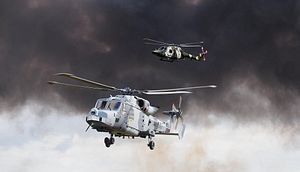South Korea’s Defense Acquisition Program Administration (DAPA) announced last week that it will push for $400 millions in offset obligations that can include technology transfers from any foreign vendor selected to supply the Republic of Korea Navy (ROKN) with 12 new anti-submarine warfare (ASW) helicopters, according to local media reports.
“(We) plan to push for an offset package with the size of around $400 million,” DAPA announced on November 8. As I reported earlier this year, DAPA initially announced this year that it will invest $768 million in a new fleet of 12 ASW helicopters. The latest procurement is part of a larger plan–known as the Maritime Operational Helicopter program–to acquire a total of 20 new anti-submarine warfare helicopters by 2022.
“We are planning to sign a deal with one of the three chopper companies by the end of 2018 and the new choppers will be gradually deployed from 2020 through 2022,” a DAPA spokesperson said in January. Contenders for the ROKN’s new ASW chopper include AgustaWestland’s AW-159, Sikorsky’s MH-60R, and the NHIndustries’ NH-90 multirole military helicopter.
The ROKN currently operates eight AW-159 Lynx Wildcat helicopters with the last batch of four ASW choppers entering service this July. Agusta Westland is now hoping for a follow-up order. The AW-159 can operate from smaller surface warships, as I explained previously (See: “South Korea Receives 4 New ‘Submarine Killer’ Helicopters”):
The helicopter, “designed to operate from the smallest helicopter-capable ship,” according to the the Leonardo-Finmeccanica company website, is powered by two LHTEC CTS800-4N engines and has a maximum range of 265 nautical miles (490 kilometers). It primarily functions as a ASW aircraft, but can also be deployed in other missions.
“The platform is equipped with the latest communications, navigation systems, advanced sensors and a wide range of weapons, providing mission commanders with Intelligence Surveillance and Reconnaissance (ISR), Maritime Interdiction Operations (MIO), Anti Surface Warfare (ASuW), Anti Submarine Warfare (ASW) and Search and Rescue (SAR) capabilities,” according to the company website.
The helicopters [is] equipped with a Selex Seaspray 7000E active electronically scanned array radar and a Thales Compact FLASH Sonics low-frequency, long-range dipping sonar system, next to other ASW sensors, including sonobuoys.
The multi-mission maritime helicopter will likely be armed with Spike NLOS missiles, K745 Cheong Sangeo (Blue Shark) light-weight torpedoes and depth charges. The aircraft can stay in the air for 2-3 hours depending on the load.
It is probably the case that DAPA will select the AW-159. It has outperformed its other competitor, the U.S.-made MH-60R Seahawk helicopter, during trials in 2012 and the ROKN has so far been satisfied with the helicopter’s operational performance. The helicopter model will likely be selected in the coming months and a contract is expected to be signed by the end of 2018.































